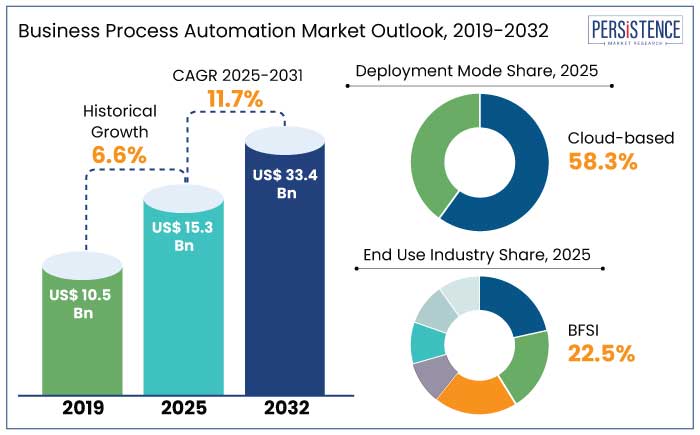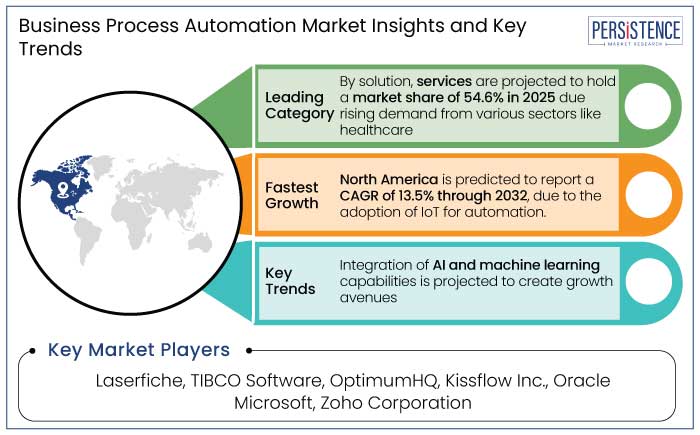Industry: IT and Telecommunication
Published Date: January-2025
Format: PPT*, PDF, EXCEL
Delivery Timelines: Contact Sales
Number of Pages: 184
Report ID: PMRREP33620
The global business process automation market is anticipated to reach a size of US$ 15.3 Bn in 2025. It is predicted to rise at a CAGR of 11.7% through the assessment period to attain a value of US$ 33.4 Bn by 2032.
Business Process Management (BPM) continues revolutionizing industries by enhancing agility, efficiency, compliance, and visibility. Companies like IBM, Accenture, and Genpact are leveraging AI-powered BPM for automation and predictive analysis, reducing costs and improving operational speed.
In September 2023, iGrafx partnered with Zeitworks Technologies to offer cutting-edge process intelligence tools, boosting BPM capabilities globally. BPM's potential is evident in the healthcare sector, where Infosys, Kissflow, and BP Logix enhance clinical workflows, administrative tasks, and regulatory compliance.
Governments are accelerating BPM adoption in healthcare, like the Tasmanian Liberal Government's US$ 150 Mn digital health upgrade. They are aiming to improve care access and efficiency. Hence, BPM remains crucial for innovation and continuous improvement.

Key Highlights of the Market
|
Market Attributes |
Key Insights |
|
Business Process Automation Market Size (2025E) |
US$ 15.3 Bn |
|
Projected Market Value (2032F) |
US$ 33.4 Bn |
|
Global Market Growth Rate (CAGR 2025 to 2032) |
11.7% |
|
Historical Market Growth Rate (CAGR 2019 to 2023) |
6.6% |
North America's strong tech infrastructure, well-established IT environment, and early embrace of automation position it set to lead the worldwide BPA industry. In 2025, North America is projected to hold 39.2% of the global BPA industry share, reflecting its leadership in leveraging AI, machine learning, and IoT for automation. The region’s market is predicted to report a CAGR of 13.5% from 2025 to 2032.
The widespread adoption of cloud-based RPA solutions and real-time data analytics tools has bolstered the region's market dominance. For scalability and innovation in a cutthroat global market, North America-based companies are incorporating customer experience optimization and compliance management into their business process outsourcing strategy.
Asia Pacific is gaining momentum in the global BPA industry due to rapid digital transformation and automation adoption in manufacturing hubs like China and India. The region is predicted to be the fastest-growing market, with a projected CAGR of 15.8% from 2025 to 2032. It will likely hold 28.7% of the global business process automation market share in 2025, driven by aggressive investments in digital infrastructure. For example,
In the BPA industry, the services segment is set to account for 54.6% of the market share in 2025, driven by awareness of the importance of BPA solutions and their role in achieving operational efficiency. Businesses are increasing their investments in professional services like consulting, implementation, and maintenance to ensure the seamless integration of automation tools into their existing processes. For example,
The platform segment is set to rise rapidly due to technological innovations like AI, machine learning, and IoT integrations. For instance,
In 2025, cloud-based BPA software is projected to lead the market with a 58.3% share due to its accessibility, adaptability, and cost-effectiveness, reflecting a shift toward scalable, on-demand solutions. Cloud platforms enable real-time collaboration, making these particularly valuable in remote and hybrid work environments. For instance,
Increasing reliance on cloud BPA for real-time monitoring, predictive analytics, and seamless scalability across industries is a significant trend in the business sector.
Automation technologies like RPA and AI-powered tools are becoming immensely popular. The worldwide BPA market is booming quickly because of cost reduction, operational efficiency, and digital transformation.
Cloud-based solutions and IoT integration have fueled growth, enabling scalable, connected, and data-driven processes. The rise of remote work has raised the need for efficient workflows and effective compliance management. AI and machine learning are transforming BPA by enabling predictive analytics and real-time process monitoring, allowing businesses to remain competitive in an increasingly automated industry.

The global BPA application market recorded a CAGR of 6.6% in the historical period from 2019 to 2023. Businesses' digital transformation has increased due to the global pandemic. Around 59% of enterprises polled said they have used cloud-based solutions.
Businesses like Appian have developed free COVID-19 Response Management apps and Workforce Safety solutions to monitor health and regulatory compliance. As cloud-based solutions are inexpensive and simple to set up, their use has grown.
To cut down on human labor and time spent on cloud workloads and services, businesses require technology solutions. BPA systems with cloud automation features will likely be widely used in the sector as cloud infrastructure grows in popularity. Demand for BPA activities is estimated to record a considerable CAGR of 11.7% during the forecast period between 2025 and 2032.
Trend of Digital Transformation to Streamline Industry Operations
The emphasis on digital initiatives is accelerating the adoption of process automation technologies, enabling organizations to enhance efficiency, reduce costs, and improve customer experiences. For example,
Process automation technologies such as Robotic Process Automation (RPA), AI-driven workflows, and cloud-based platforms are driving this evolution. For example,
Organizations may stay competitive in the quickly changing technology world by implementing digital transformation, which also simplifies processes and fosters creativity through data-driven decision-making.
Emphasis on Optimized Resource Utilization to Spur Demand for BPA Processes
Employees may concentrate on their primary skills owing to business process automation, which maximizes resource use and cuts down on overhead time. BPA solutions remove manual quality assurance procedures, cut down on overhead time, and integrate systems. Workers report more free time and less time wasted. For example,
Automated business processes increase employee motivation and engagement by making jobs faster, simpler, and more productive.
Shift in Organizational Standards Hinders Adoption
Cultural resistance and organizational transformation are obstacles facing the business process automation market. BPA integration sometimes necessitates a fundamental shift, with employees frequently being used to new technology and fearing interruptions and job loss. Implementing BPA may be hampered by resistance to change, fear of compromising roles, and loyalty to established processes.
Another key obstacle is the intricacy of assuring seamless integration across several systems and technologies. Integrating various technologies and systems to maximize operations is a difficult task that organizations frequently encounter.
Global BFSI Industry to Create High Demand for BPA Technology
The business process automation market is set to be influenced by the Banking, Financial Services, and Insurance (BFSI) sector as automation is utilized to improve customer experience and safety. For instance,
BPA solutions are further transforming processes like loan approvals, fraud detection, and customer onboarding through RPA and AI-driven analytics.
Adoption of blockchain technology strengthens BPA's position in BFSI by automating security and compliance, tackling growing cyber threats, and propelling expansion of contemporary financial services.
Integration of Novel Technology to Enhance Automation Capabilities
Technologies such as AI and machine learning are transforming BPA processes by boosting capabilities. These are further allowing for data-driven decision-making, speeding workflows, optimizing operations, and giving predictive insights. For example,
In sectors like healthcare, banking, and logistics, AI/ML-integrated BPA systems improve operational efficiency, agility, and resilience by analyzing large datasets, forecasting results, and suggesting tactics.
In the global business process automation market, key players are prioritizing research and development initiatives aimed at harnessing future technologies. This focus on innovation is driving several organizations to forge strategic partnerships with other firms. It is further creating collaborative efforts to enhance their own process automation solutions and ultimately provide superior service to consumers.
In addition to established companies, a wave of start-ups is emerging, bringing fresh technological developments that inject innovation into the industry. These newcomers are not only challenging the status quo but also opening up new possibilities for efficiency and productivity in business operations. Together, these trends reflect a vibrant ecosystem dedicated to transforming the way businesses operate and engage with their customers.
Recent Industry Developments
|
Attributes |
Details |
|
Forecast Period |
2025 to 2032 |
|
Historical Data Available for |
2019 to 2023 |
|
Market Analysis |
US$ Billion for Value |
|
Key Regions Covered |
|
|
Key Market Segments Covered |
|
|
Key Companies Profiled in the Report |
|
|
Report Coverage |
|
|
Customization and Pricing |
Available upon request |
By Solution
By Deployment Mode
By Enterprise Size
By End Use Industry
By Region
To know more about delivery timeline for this report Contact Sales

The market size is set to reach US$ 33.4 Bn by 2032.
AI is set to transform orchestration by improving responsiveness, agility, and efficiency in businesses through adaptive intelligence integration and real-time operational optimization.
In 2025, North America is set to attain a market share of 39.2%.
In 2025, the market is estimated to be valued at US$ 15.3 Bn.
Laserfiche, TIBCO Software, OptimumHQ, Kissflow Inc, Oracle, and Microsoft are a few key players.